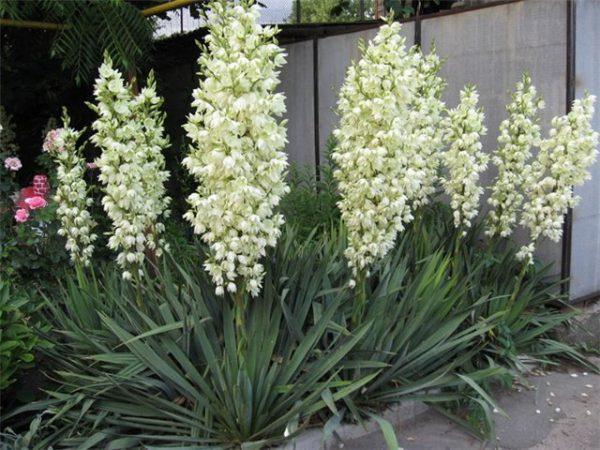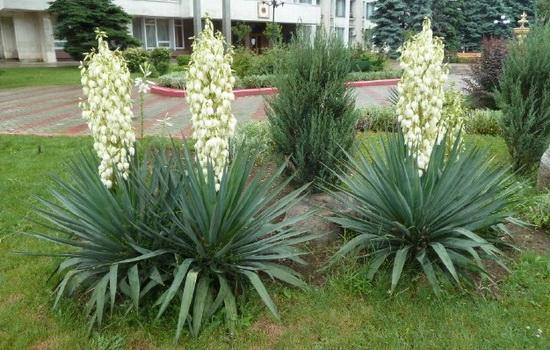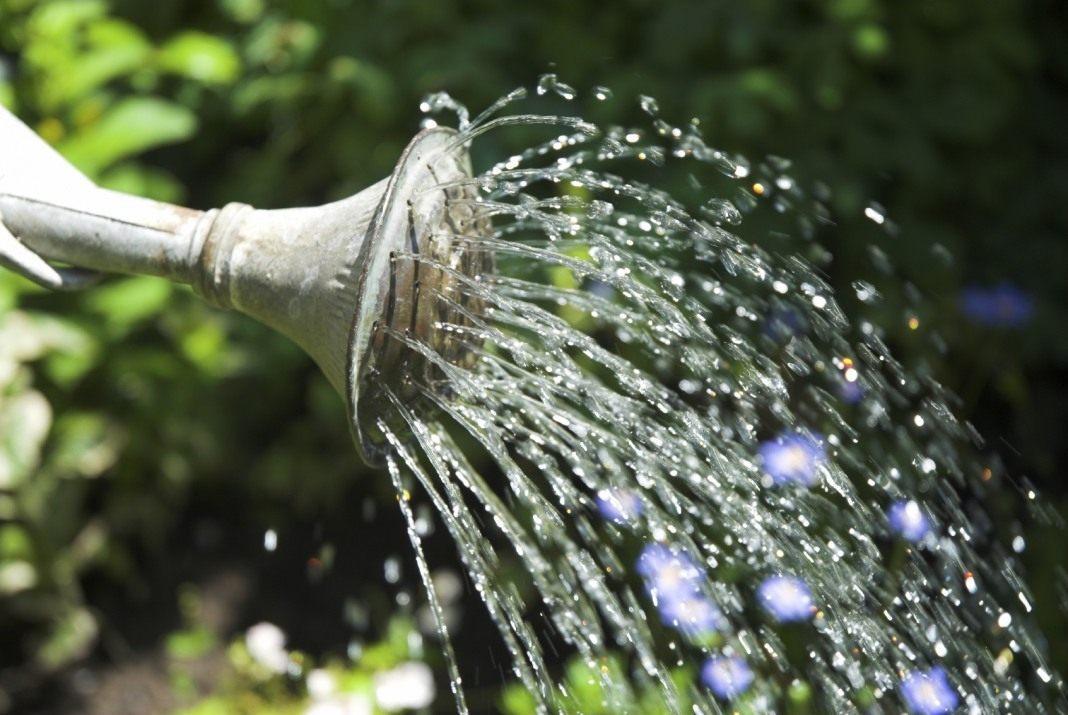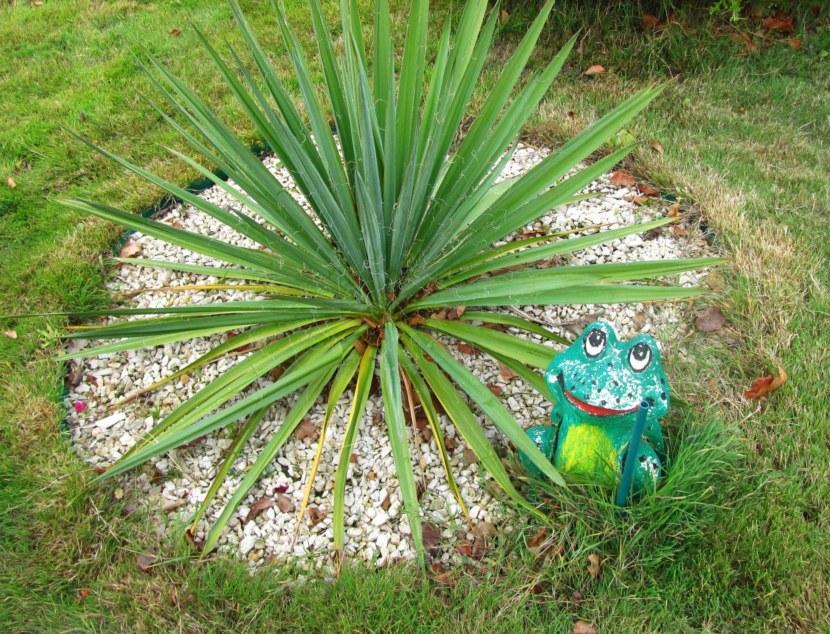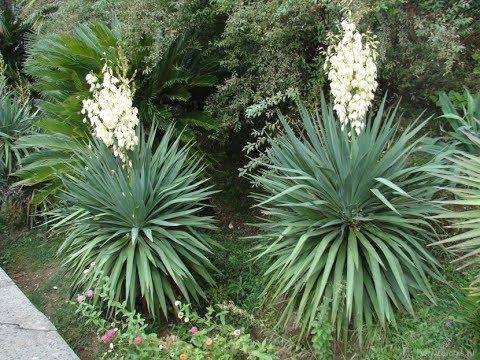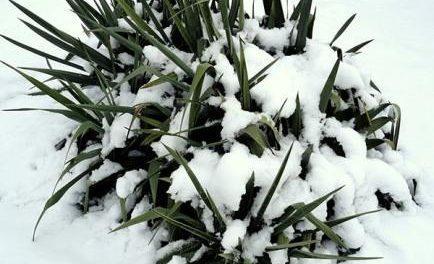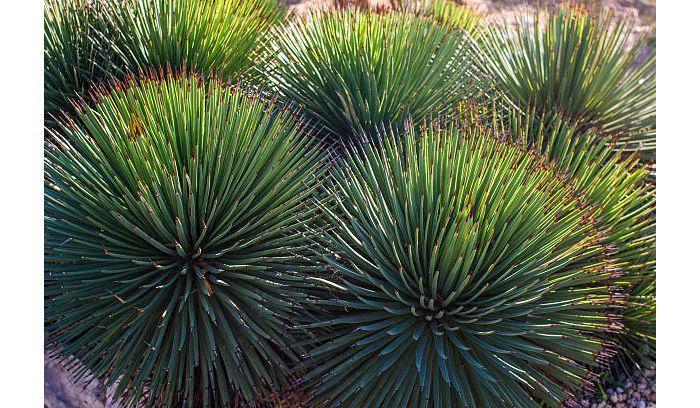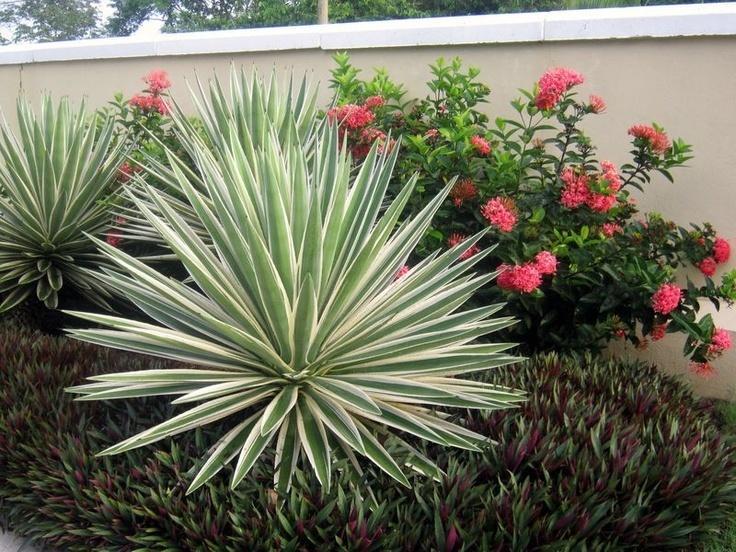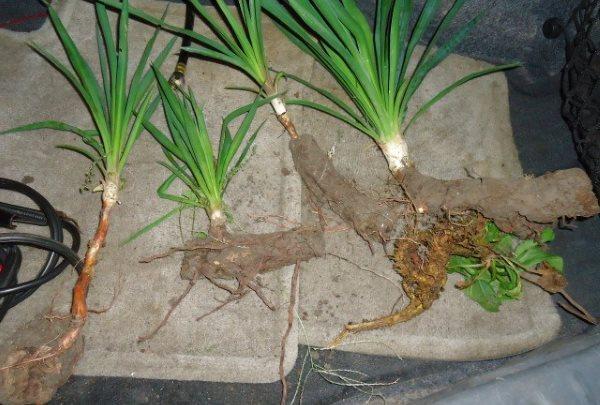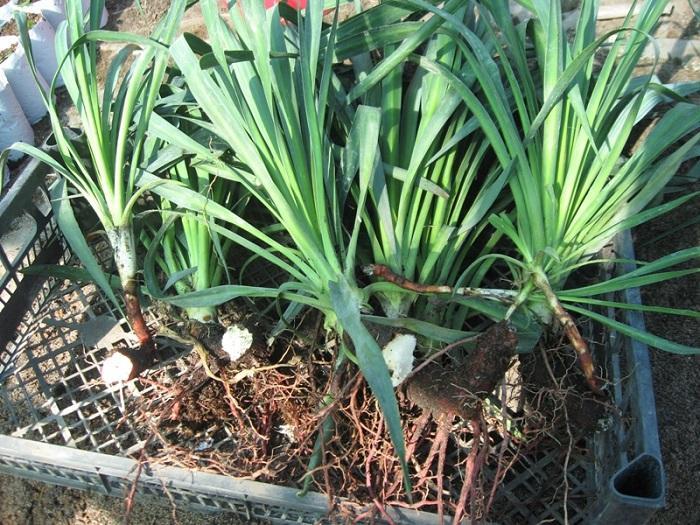Many gardeners are engaged in growing garden yucca. This culture is very popular today. It is considered an unpretentious and fairly hardy plant that can easily tolerate heat and drought. The disadvantage of the flower is its increased susceptibility to excess liquid in the soil. This can cause rot on the root system and cause various diseases. Sometimes the plant dies completely.
- Popular varieties of street yucca: description and characteristics
- filamentous
- Gray
- How to plant yucca in the garden
- Optimal timing
- Depending on the variety
- From region of growth
- Methods and technology of planting plants
- How to care: growing conditions
- Temperature and lighting in the garden
- Humidity and watering
- Transplantation in open street ground
- When is the best time to replant yucca?
- Feeding
- Yucca pruning for beauty and rejuvenation
- Plant care in winter
- Do I need to dig up yucca for the winter?
- Options for wintering yucca in open ground
- The most common diseases and pests
- How to treat diseases
- How to fight parasites
- Reproduction
- How to propagate yucca from tops
- Cuttings
- We plant the lateral shoots
- By shoots
- Stem cuttings
- Air layering
Popular varieties of street yucca: description and characteristics
Before planting this flower outside, you need to choose the right variety. There are several types of yucca that have certain characteristics.
filamentous
This culture comes from North America. It is a stemless bush whose long leaves grow directly from the roots. During the summer, shoots appear on the roots, which are used for propagation. The plant is resistant to frost, but it is recommended to cover it for the winter.
Gray
This plant is native to the western regions of America. Such variety of yucca has a low stem. Dormant buds are located on it. Their growth begins when the leaves collected in a bunch die. The inflorescences of the culture reach 1 meter in height. They are covered with a large number of white bells.
How to plant yucca in the garden
To get a strong and viable plant, you should pay attention to the timing and technique of planting it.
Optimal timing
The best time to plant yucca is in May. The soil should warm up sufficiently. It is this method that gives the plant enough time to prepare for winter.
Depending on the variety
Regardless of the variety, yucca is planted in the spring and summer.The temperature should reach 20-22 degrees. This allows the crop to form strong roots.
From region of growth
Planting yucca in the fall is only permissible in the south. But, in any case, planting work should be carried out as early as possible - at the end of August or beginning of September. The plant takes a lot of time to take root. In the Moscow region and other regions, the crop is planted only in the spring.
Methods and technology of planting plants
In order for the culture to take root, the following recommendations must be followed when planting:
- do not deepen the root collar too much;
- the hole should be twice as large as the size of the roots;
- on dense soil it is recommended to install a drainage layer - its thickness should be at least 10 centimeters.
Place the plant in the central part of the prepared recess and carefully straighten the root system. The top should be covered with earth and soil mixture, pressed down and watered.
You should also check the location of the roots and mulch the bed with dry peat.
It is prohibited to use any kind of powder to decorate the ground under the yucca. They contribute to soil compaction and reduce the flow of oxygen to the roots.
How to care: growing conditions
The plant must be properly cared for. After planting, yucca needs moderate watering. It is also worth carrying out sanitation work and pruning. Timely application of fertilizers is of no small importance.
Temperature and lighting in the garden
The shrub requires good lighting and warmth. Therefore, it is planted in open beds that receive a lot of sun. Partial shade is also a good option. A lack of light will provoke a decrease in the volume of green mass. The plant is not afraid of drought. It can reproduce at temperatures of approximately 20 degrees.
Humidity and watering
The soil should not be too wet. The plant does not need abundant watering. The need for water can be determined by the appearance of the crop. If the leaves are straightened and the threads are slightly curled, the yucca does not need to be watered. If the foliage curls and the threads sag, moisture is required.
In winter, the plant also needs to be watered. However, it is recommended to reduce the amount of water. It is recommended to water the plant directly at the root. It is strictly forbidden to use too much moisture. This will cause root rot.
Transplantation in open street ground
If a crop grows in one area for a long time, this provokes its excessive growth. Therefore, the plant should be replanted. In a new place, the yucca begins to grow better.
It is recommended to perform the procedure in spring or late summer. It is worth considering the following features:
- when digging up a bush, it is important to avoid damaging the roots - they can go as deep as 70 centimeters;
- shoots in the bush area need to be dug up and planted as separate plants;
- the culture should be provided with the same environmental features as in the old site;
- the transplanted plant requires fertilization;
- After the procedure, the bush will be able to bloom only after 1 year.
When is the best time to replant yucca?
It is worth replanting the crop in late summer or spring. This can be done from August to the first days of September.
Feeding
Flowers do not like mullein, bird droppings, or green fertilizers. In general, you should fertilize the crop very carefully. With an excessive amount of fertilizer, the leaves become large and the flowers are absent. Frost resistance parameters also decrease.
A young crop definitely needs to be fed after planting. However, this is done at the moment new leaves appear.It is best to use products that are designed for indoor succulents. A complex preparation with a low nitrogen content is also suitable. It is diluted by half. 1-5 liters of fertilizer are applied under the bush - it all depends on its size.
Yucca pruning for beauty and rejuvenation
Pruning is performed to form new shoots and rejuvenate the crop. To awaken the side buds, you need to cut off the main stem. This activates the development of lateral buds, from which rosettes will appear. If there is no need for shoots, it is enough to get rid of the damaged leaves.
Yucca looks great when it grows in a single stem. With adequate care, the height of the peduncle is more than 1.5 meters. In this case, the number of flowers can be 250. Therefore, before starting pruning, you need to analyze its feasibility.
Most often, the crop is pruned in the fall, after flowering has ended. In this case, you need to get rid of bad leaves and stems. To improve the appearance of the crop, the leaves need to be cut off not completely, but 3-5 centimeters away from the trunk. Thanks to this, the trunk will be covered with scales.
Plant care in winter
In order for a crop to survive the winter season well, it needs to be provided with complete and high-quality care.
Do I need to dig up yucca for the winter?
The advisability of digging up a crop depends on its variety. Gray and filamentous yucca are characterized by frost resistance. Plants easily perceive a short decrease in temperature. If a cold winter is expected in the region, the bush requires shelter. In the first 2 years of life, young crops need to be covered.
Options for wintering yucca in open ground
You can cover the plant in various ways. Preparation for winter is carried out as follows:
- In dry weather, the bush should be gathered into a bundle and tied with a rope.To prevent the ground from freezing, the lower leaves should be placed on the ground. The area around the plant is covered with dry leaves. Boards and sticks are stacked on them. The plant must be covered with film, and the base of the trunk must be covered with earth.
- The plant can be covered with a loose wooden box. It should also be covered with foam plastic or roofing felt. Sprinkle with dry leaves and cover with straw or spruce branches. Wrap the top of the bush with film.
It is recommended to carry out insulation work at the end of October or beginning of November. Protective devices should be removed only after the threat of frost has been eliminated.
The most common diseases and pests
Yucca can face various diseases. The plant is also susceptible to pest attacks. To cope with the problem, you need to take timely measures.
How to treat diseases
The plant often encounters fungal pathologies, which are accompanied by the appearance of spots on the leaves. Excessive watering becomes a provoking factor for problems.
Rotting of the foliage is also considered a common disease of yucca. This disorder is also fungal in nature.
White rot is considered a common disorder. It is caused by sharp fluctuations in temperature in combination with high humidity. White bloom can damage the leaves and stem. To cope with fungi, yucca is sprayed with fungicides and the affected foliage is picked off.
How to fight parasites
The plant is susceptible to attacks by the following pests:
- Slugs – cause yellow spots to appear after winter. Insecticides help control pests.
- Scale insects - provokes the appearance of brown plaques on the plant. Wiping the foliage with a damp cotton swab will help deal with the problem.You can also use chemicals such as Actor.
- Spider mites - the drug Iskra BIO will help you cope with pests.
Reproduction
Garden yucca is propagated in different ways. To achieve good results, you need to strictly follow the technology.
How to propagate yucca from tops
This is the most popular method. To implement it, you need to take a rosette of leaves at the top. A broken branch will also work. The cuttings need to be dried for 2 hours and the lower leaves removed. Then it is planted in nutritious soil and covered with a jar. The ground should be slightly damp.
Cuttings
Yucca propagates by cuttings in the first half of spring or at the end of winter. Usually the procedure is carried out on an adult plant, during the formation of the crown, when excess shoots are removed. The cuttings should be dried for 1 hour and transplanted into a mini-greenhouse. After 1.5 months, roots will appear. At this point, the plant can be adapted to normal conditions.
We plant the lateral shoots
To plant a growing yucca, you need to make an incision at the root. It is performed below the lower leaves by about 40 centimeters. In this area, you need to remove 1.5 centimeters of bark. A layer of damp moss is applied to the damaged area and wrapped in film. This helps prevent moisture evaporation.
After some time, dormant roots awaken in this area. As they grow, they form cuttings. When the roots have grown sufficiently, the cuttings are cut off. The cut must be treated with crushed activated carbon and placed in the substrate.
By shoots
In such a situation, it is necessary to separate the excess shoots, which lead to excessive plant density. In this case, the cuts must be sprinkled with charcoal to prevent rotting.Then it is recommended to move the sprouts into coarse sand and place them in a greenhouse for rooting.
It is recommended to water the seedlings moderately and periodically ventilate to remove condensation. With adequate care, the first roots will form within 1.5 months. Then the plant can be moved into a pot.
Stem cuttings
This method is suitable for qualified flower growers. After cutting off the tops, the plant is left with trunks without leaves. The length of the flower trunk must be at least 25 centimeters. All cuts should be lubricated with garden varnish. You can also use activated carbon. Then a root formation stimulator is used. After the necessary manipulations, the trunk should be planted in nutritious soil.
Air layering
This method should be used to plant yucca during rehabilitation after illness. To do this, you should take only hard areas. Remove the bark from the bottom cut and cover it with moss. It needs to be moistened periodically. After 1 month, small roots will form. They should be grown to 5 centimeters. The yucca is then planted in suitable soil.
Yucca garden is a popular ornamental plant that is easy to care for. To get a strong and powerful crop, you should monitor watering. It is also recommended to prune the bush and apply fertilizer.

